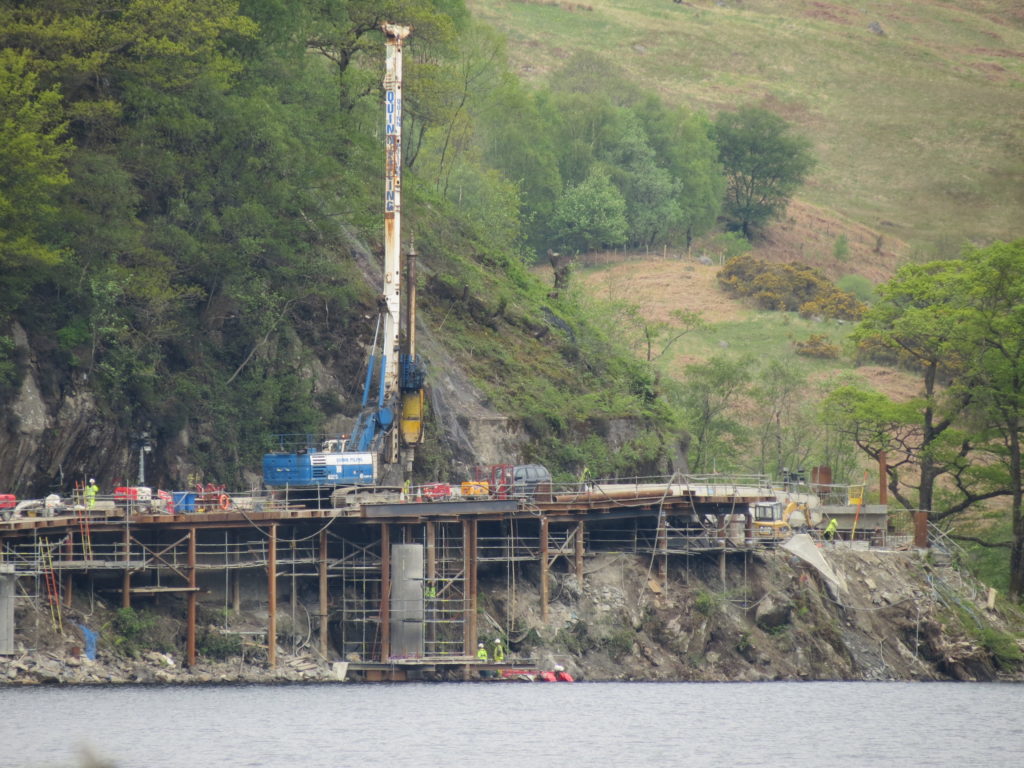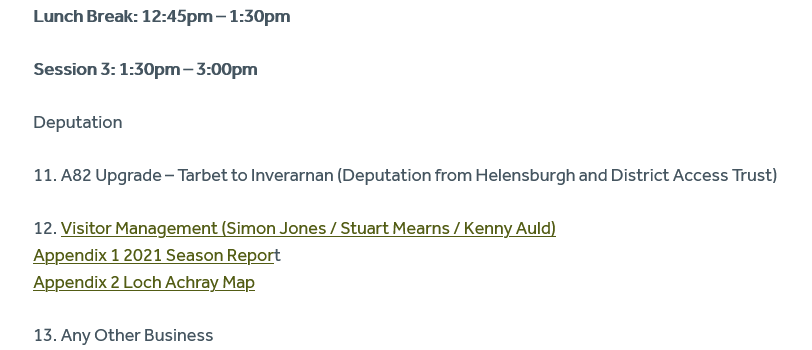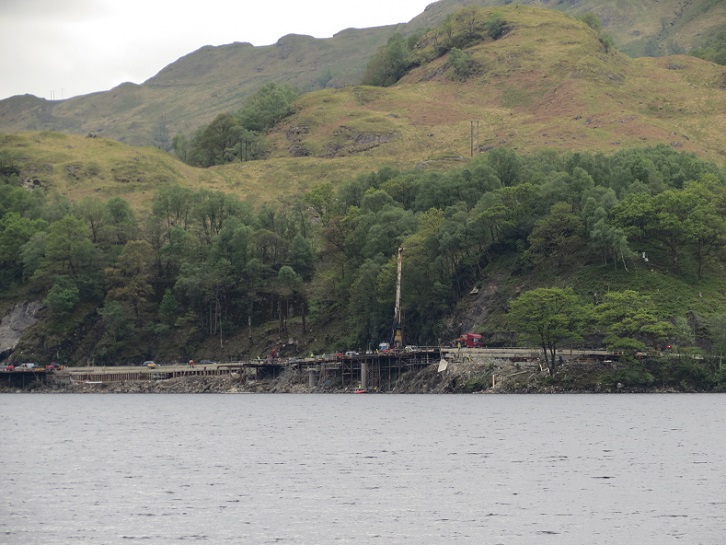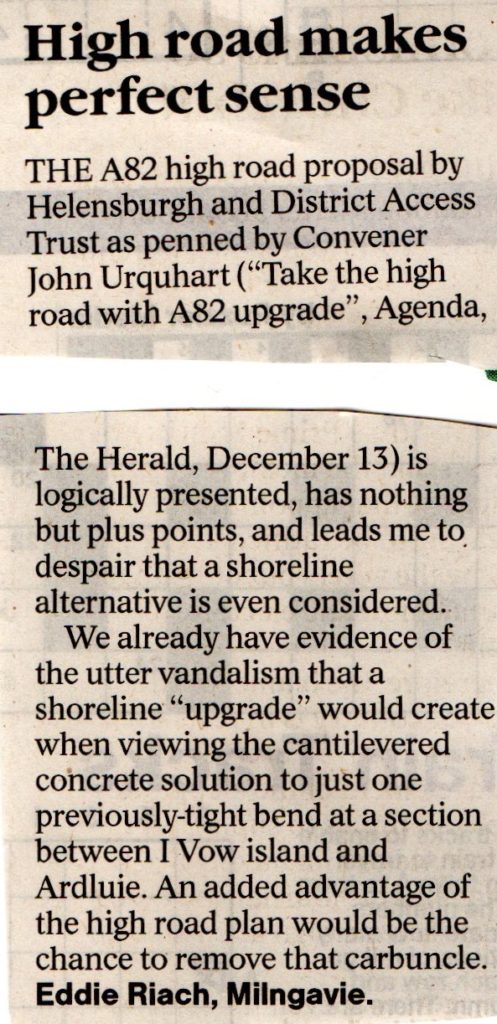
Following his post on the A82 upgrade (see here), John Urquhart and other volunteers from the Helensburgh and District Access Trust (HADAT) requested a deputation to the Loch Lomond and Trossachs National Park Authority Board on their alternative proposals for a high road linking Tarbet and Invernan. This was accepted and the HADAT delegation was put on the agenda…………. for the prime after-lunch slot!

Unfortunately, while it was clear from the later discussion that Board Members had been sent copies of HADAT’s proposals and some had read them carefully, they weren’t published on the LLTNPA website along with the other meeting papers. That meant that unless a member of the public observing the meeting had read John’s post on parkswatch, they would not have known what HADAT is proposing. This was not HADAT’s fault: with deputations limited to five minutes, they had to focus on the arguments rather than explaining the detail of their proposed route.
Unfortunately too, unlike most Local Authorities, the LLTNPA still refuse to make the recordings of their meetings available online. That rather confirms what I noted in my short post on the change in the arrangements for the meeting (see here), the last people the LLTNPA want to put in the picture are the public whom they are meant to serve.
There is no doubt, however, that the deputation has had an impact.
The Chief Executive’s report to Board Members about the upgrade
Hidden away in the CEO’s Report (see here), which was considered after the morning break, there were four pages on the A82 upgrade. This appears to be first time there has been any substantive report to Board Members on the issue since Transport Scotland started their consultation on route options back in 2013. All thanks to HADAT’s deputation.
Gordon Watson’s justification for nine years of silence about the upgrade proposals was that:
“the National Park Authority will only be able to take a considered view on the whole scheme once a design has been finalised.”
This claim, as Mr Watson should know, is contrary to the entire direction of travel of the Scottish Parliament’s attempts to reform the planning system, where the emphasis is on early engagement and the importance of early consideration of development proposals to ensure they are in the right place.
Transport Scotland has a standard three stage design process which starts by looking at route options – that is the crucial stage. In 2013 Mr Watson, who was then directly responsible for planning in the National Park, allowed Transport Scotland to choose the shore route as their preferred option (see here), without proper consideration of the alternatives and without the involvement of his Board. Mr Watson’s decision has made it very hard, if not impossible, for the Board to lodge an objection at the final stage without the LLTNPA losing face. Why let Transport Scotland incur all the expense of ground investigations along the loch shore if you are then going to object to their plans?
Several Board Members picked up on this, asking that their role was in the process and what power they had to challenge Transport Scotland’s decision. The answer is that, as a statutory consultee, if the LLTNPA object to the upgrade that could trigger a public inquiry. Just imagine the LLTNPA trying to explain to the Reporter – the name for the person overseeing such an inquiry – why they had kept quiet for ten years. Sadly no Board Member thought to ask Gordon Watson why, given the Cairngorms National Park Authority Board was involved in considering issues with the Beauly Denny powerline upgrade right from the start, he hadn’t chosen to do the same with the LLTNPA Board on the A82 upgrade?
All credit, however, to the LLTNPA ecologist, Alan Bell, for describing the extent of the damage that will be caused by the upgrade work: the carbon cost of concrete and blowing up areas of rock; significant areas of ancient native woodland native destroyed; the shoreline of Loch Lomond scarred, with landscape cuts on past experience taking 40 years to soften; and the ability of the public to enjoy the loch barely improved. His conclusion: there are “no easy or obvious solutions” to Transport Scotland’s preferred route. No-one disputed that.
How that consensus, that this development will be extremely damaging, fits with the claims made in Gordon Watson’s report is unclear:
“Environmental design principles were agreed during this stage were developed in line with Transport Scotland’s Fitting Landscapes guidance, to ensure that the proposed scheme was designed with respect of the distinctive local landscape character, quantities and cultural heritage of the National Park and the National Scenic Area”.
HADAT’s deputation
In a brief presentation John Urquhart made a number of points that focussed on the recreational perspective:
- There is very high demand from the public to be able visit beautiful lochside locations and from the perspective of a National Park Authority there should be nothing more important than this;
- The new path it is proposed to build along the A82 is so close to the road that it will not be a pleasant experience;
- We already know from the upgrading of the A82 between Balloch and Tarbet of what can go wrong.
He then asked the question, “how important does the National Park think this shoreline is?”
The Convener of the LLTNPA, James Stuart, immediately stamped on this saying it was not the place of the deputation to ask questions of the Board and urged the deputation to use the rest of the five minutes they had been allotted to put their case.
HADAT’s question, however, is the right one and needs answering: is the LLTNPA Board content to see the destruction that has taken place at Pulpit Rock carry down the shore of Loch Lomond to Tarbet?

After a rather good question from Board Member Martin Earl to officers about the extent to which Transport Scotland had considered the possibility of a higher route at the options stage (Gordon Watson didn’t know but Alan Bell clarified that HADAT had come up with a much more specific proposal than anything Transport Scotland had considered) the Convener and his Depute tried to go on the offensive.
Had HADAT participated in Transport Scotland’s first consultation, James Stuart wanted to know? Yes, replied John Urquhart, HADAT had attended a consultation session in the Arrochar village hall in 2013 with the consultants, Jacob’s, and advocated alternatives then. They were given the very strong impression that a decision on options had effectively already been made. Consultees had been presented with a “flyover” of the shoreline proposal which was very similar to the “flyover” in Transport Scotland’s most recent consultation. Touché!
Then it was Will Nisbet, the Depute-Convener’s turn. After asking what the reaction from the Scottish Government would be to an alternative route after all the money (£140m) that had been spent widening the A82 at Pulpit Rock, he challenged whether a higher route could be faster and safer while offering good views. What about the risk of accidents of people looking out the window?
In response to the first part of the question John Urquhart stated that HADAT had put in an FOI to Transport Scotland about the costs of the various options and had never had a reply. He urged the National Park Authority to ask Transport Scotland this question. In response to the second, he pointed out that it would be people like passengers in tour buses, not drivers, who would be able to enjoy the views from a higher route but that HADAT’s proposals also included a number of viewpoints where drivers could stop off safely.
At which point James Stuart asked another member of the delegation, Jack Fordy, to respond to the issue of the investment at Pulpit Rock being wasted. (Both James Stuart and his Depute-Convener seemed unaware that the Pulpit Rock “improvements” had been a stand-alone decision, the planning for which started in 2006, well before Transport Scotland’s consultation on route options for the new road in 2013). Mr Fordy introduced himself as a cyclist and pointed out that no cycle path had been included in the road widening at Pulpit Rock. That improvement therefore would no longer be fit for purpose if Transport’s Scotland preferred option, which incorporates a cycle path along the length of the upgraded road, went ahead. This wouldn’t matter, however, if the current A82 ceased to be used as the main road and was dedicated instead to local access, cyclists, walkers and drivers wanting to stop off by the loch. Touché!
With great diplomatic skill Mr Fordy then stopped the fencing and handed the LLTNPA a get out of jail card: there had been a massive increase in walking and cycling since 2013 – he avoided the usual “active travel” jargon – as a result of which, he suggested, circumstances are now very different to what they were then. You could sense the relief. There are plenty of reasons the LLTNPA could use to justify opposing Transport Scotland’s upgrade proposals at this late stage, not just recreation but the climate and nature emergencies.
Further questions from Board Member David McCowan, who suggested any decision would ultimately be determined by money, elucidated an admission from staff that they didn’t know the cost of the various options.
The highlight of the discussion, however, came with Billy Ronald, who lives and works just up the road in Strathfillan and up until now has said very little in the middle class milieu that is the National Park Board. “I know the ground well”, he said, before going on to say he thought HADAT’s proposal was a far better idea than the route along the shore. James Stuart, instead of asking Billy the reasons for his views, retorted to the effect that it was not appropriate for Board Members to express their private opinions in the public realm. You can understand why the LLTNPA doesn’t make recordings of Board meetings public, this would have gone viral.
If James Stuart was still a Major in the army – he dropped the title on his appointment to the Board – I am sure he would have had Billy court martialled. But in my view it was James Stuart, stifling democracy, not Billy Ronald who was in the wrong. Mr Stuart’s action reminded me of the attempts by Peter Argyle, then convener of the Cairngorms National Park Authority Board, to gag Councillor Bill Lobban five years ago (see here). But that was an attempt to force Board Members to support decisions once they were made. This was far worse, an attempt to prevent Board Members expressing their opinions.
What needs to happen now?
While several Board Members welcomed HADAT’s deputation and the opportunity this had given them to discuss the upgrade, James Stuart studiously avoided making any commitments to future action and left it that the LLTNPA will consider Transport Scotland’s proposal when it is finalised, i.e. when it is too late. Mr Stuart could have asked staff to pursue Transport Scotland for the costs of various options, as John Urquhart had requested, or called a further special Board Meeting to consider the issues in detail. He chose, however, not to do so and that is unlikely to change without public pressure.
Public pressure, however, is only going to increase. HADAT had somehow and very cleverly got the Herald to publish an Agenda piece on their proposals, the same day they met the Board (see here). The Friends of Loch Lomond and Trossachs, while not going so far as to reject the shore-line route, have expressed serious concerns about Transport Scotland’s proposals in the latest issue of their magazine, the Voice. In my view as soon as the general public realise Transport Scotland’s A82 upgrade proposals will have an even greater impact on the landscape and natural environment of Loch Lomond than Flamingo Land’s proposals for Balloch, there will be uproar. LLTNPA Board Members have a responsibility to act now.


My preference would be not to carry out any work at all, and to re-route commercial traffic and any other wide vehicles, via the A84 or A83.
or put it on a train to Fort William and anywhere in between!
Once again we see intensive run around of consultation,close observance of regulatory structures and committee procedures and a huge number of officials operating as if with blinkers on.. Arcane procedures and distraction of process are all being being studiously observed , (as indeed they have been for well over 60 years, by successive local authorities and so many of the earlier UK Dept for Transport ministers.) Why is this matter of a lifeline route even being consigned to alteration by Wildlife pressure groups and local opinion of those who hardly need to use it anyway, as if it were some sort of glorified leisure-time country park bridleway or footpath?
This historic route is strategic to UK NATIONAL interests. An Upgraded A82 is as essential to the reduction and ending of the wasteful carbon based economy as it is for the wider prospects for future jobs and prosperity across the central west Highlands. It is absurd to suggest the traffic which might use it should be diverted onto A84 and A 83 or consigned to the 19th century rail line. Two coaches cannot pass each other safely along so much of Tarbert -Inverarnen . In any case recent events ably demonstrate both A83 and A 84 are woefully substandard trunk roads also.
Why should taxpayers in the western Highlands be forced to travel at less than 25 mph along a widened cart track just to the reach Glasgow airport, or access Scotland’s largest city and its huge hospital, when other Scots can get easy access by dual carriageway, by train and bus . Why should parcel deliveries cost so much more for those north of this historic bottleneck.
There are plenty of moments when protection of the Natural environment deserves resolute and effective priority – as is well known around the world ,( except in Scotland it would seem,)any really good highway has only to be built once..ever.
Continuing to ignore those who need decent infrastructure connections with the world economy is cruel. Generation after generation of Government officials have prevaricated over this section of A82 . Failure to reach any really sound conclusion while chasing tails in some ceaseless committee room runaround of debate is a national disgrace.
As I have written before in a number of earlier comments: The strategic valley south of Zurich lends access from the central valley of Switzerland to the whole upper Rhine, and onwards towards direct routes to the higher alps to Italy and through Austria. It passes through a gorgeous scenic area south of Zurich which is – dare I say it – even more spectacular than Loch Lomondside. For pure economic imperatives this had to become an autobahn..so the Swiss buried it. The road vanished. Do please Look up “Walensee”….
You take the High Road and I’ll take the Low Road
The A82 is the Western Highlands’ A9 and unlike it has been starved of successive Scottish Government investment. As Tom says, it time to invest in it properly. However, it is eminently sensible to develop a strategic route that meets Transport Scotland’s overall, if somewhat blinkered, “time savings” approach to investment AND constructing a route that opens up the loch-side to recreational users and creates a “must visit” piece of access infrastructure of the old A82 that will transform access to the western shoreside of Loch Lomond. This may take more investment (we don’t yet know) and more thought and planning, but a ‘High Road’ route would have two outputs: a new ‘High Road’ A82 that is faster, higher capacity, safer with lower environmental and visual impact and the old ‘Low Road’ A82 that opens a whole new swathe of loch-side to public recreational access, creating an infrastructure that allows a step change in its use by citizens and visitor. A win:win for the public, Transport Scotland and LLTNP, surely? LLTNP just need to get off their hands and do something and fast.
Buried in the CEO’s Report was information on the path/cycle way ” A shared footway/cycleway running adjacent to
the carriageway is being designed into the scheme, from the edge of Tarbet to the north beyond Inverarnan. The footway/ cycleway will be an approximate width of between 2m and 2.5m dependent on the constraints along the route.” I have just had confirmation that, in fact, the path/cycle way will be built to current design standards. These are for a verge of 2.5m and a width ideally of 4m with an absolute minimum of 2.5m; far wider than in the Report. This is not the impression given in the video used in the consultation which suggests something without a verge between 1.5m and 2m as at Pulpit Rock but the reply was on behalf of the relevant ministers. For those who think the High Route is too expensive contemplate the cost of an extra 6.5m width on the viaducts.